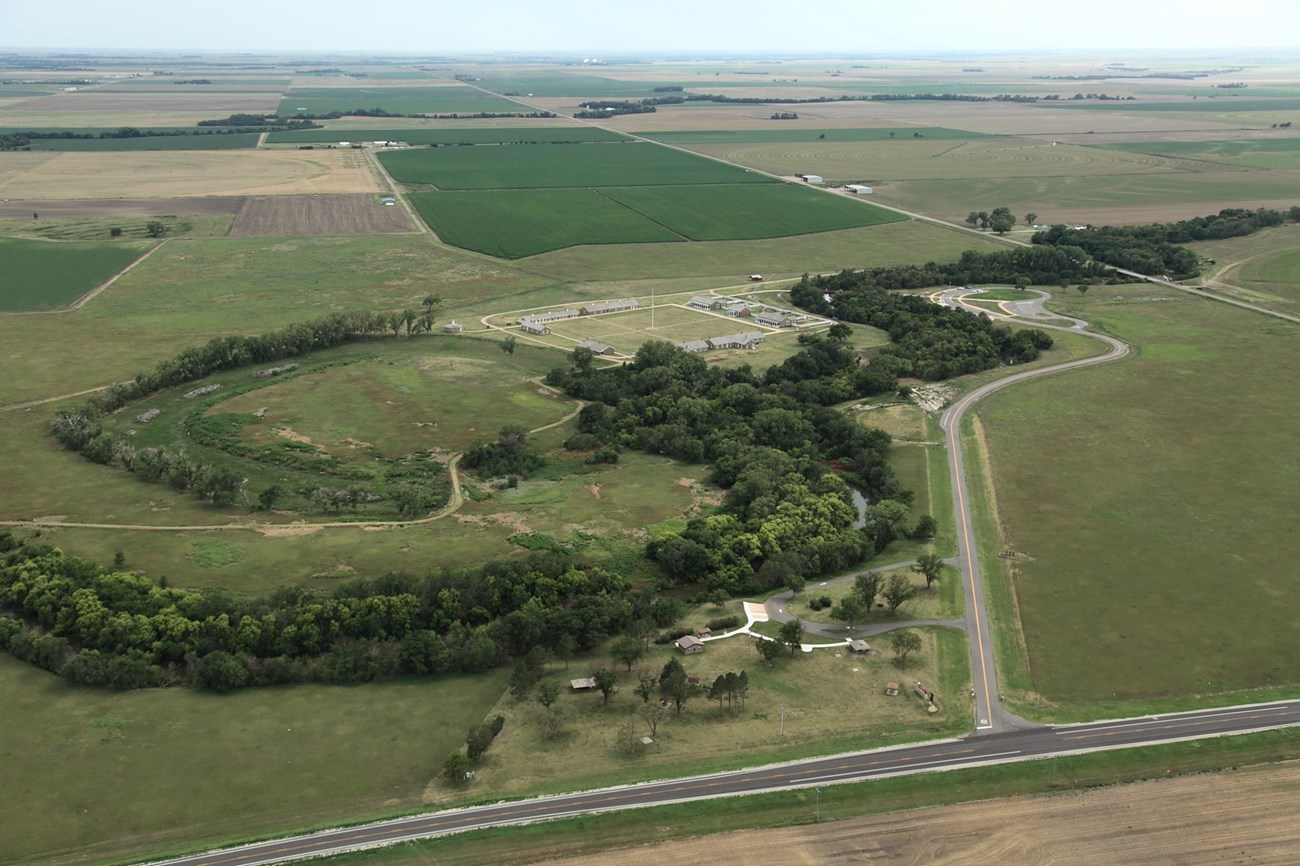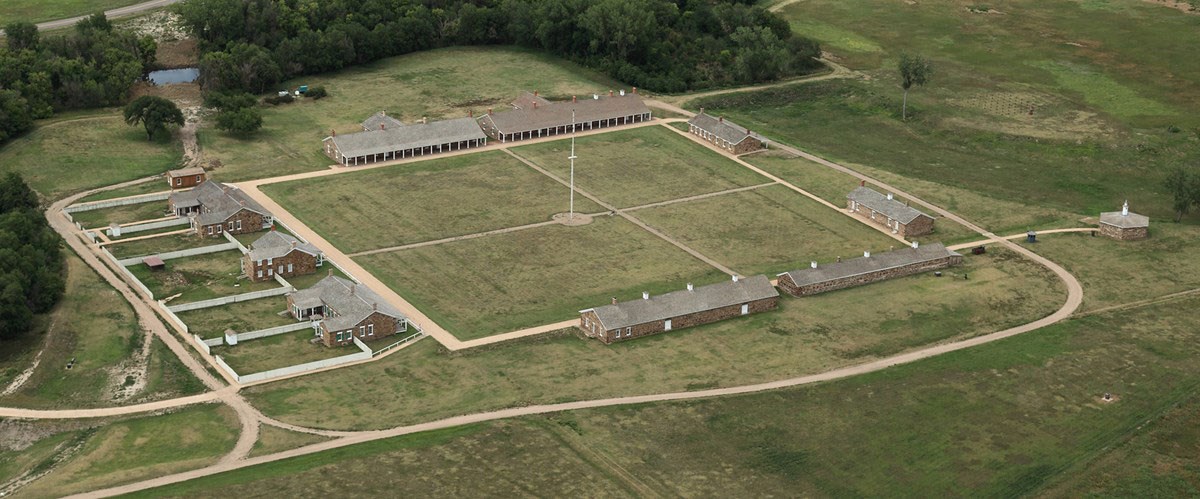Last updated: June 18, 2024
Article
NPS Geodiversity Atlas—Fort Larned National Historic Site, Kansas
Geodiversity refers to the full variety of natural geologic (rocks, minerals, sediments, fossils, landforms, and physical processes) and soil resources and processes that occur in the park. A product of the Geologic Resources Inventory, the NPS Geodiversity Atlas delivers information in support of education, Geoconservation, and integrated management of living (biotic) and non-living (abiotic) components of the ecosystem.

Introduction
Fort Larned National Historic Site (NHS) preserves the site of Fort Larned, a military outpost active between 1859 and 1878 that was located near the midway point of the Santa Fe Trail in Pawnee County in central Kansas. The historic site encompasses 718 acres, most of which are federal, and includes a small detached parcel about 3.5 mi (5.6 km) to the south that preserves wagon ruts of the Santa Fe Trail.
Geologic Features and Processes
Fort Larned is located on the floodplain of the Pawnee River adjacent to a large oxbow. The Pawnee River floodplain is a broad, flat alluvial plain consisting of Quaternary sand, gravel, silt, and clay. The meandering river and the oxbow gave the fort natural protection on three sides, leaving only the south side open. But the nearly flat grasslands to the south allowed expansive views of any approaching parties.
The Pawnee River runs through the historic site from west to east, in a meandering course. The Pawnee River flows 198 miles (319 km) from its headwaters in Finney County, Kansas and drains an area of 2,700 square miles (7,000 square km). It joins the Arkansas River eight miles (13 km) downriver from the historic site. The overall drainage pattern of the Pawnee River is dendritic, indicative of nearly horizontal underlying rocks and lack of structural features in the area. The Pawnee was once a clear, sandy perennial river. Today, as a result of irrigation practices, both the Pawnee and Arkansas rivers are intermittent and flow only after significant precipitation events.
Bedrock is not exposed in Fort Larned NHS. Geologic units present at or near the subsurface of Fort Larned NHS are limited to the Quaternary. The area’s surrounding geology provided building stone quarried from several different formations. The closest bedrock exposure is of the Cretaceous Dakota Sandstone at Jenkins Hill approximately 3 miles to the east.
The detached Santa Fe Trail Ruts unit lies on gently rolling uplands of Quaternary loess. Loess deposits in Pawnee County consists of calcareous, buff-colored silt with minor amounts of clay and fine sand with an average thickness of 6 to 10 ft (2 to 3 m).

Geologic Setting
Fort Larned NHS is in the Arkansas River Lowlands, one of 11 physiographic regions in Kansas. The Arksansas River Lowlands is a relatively flat alluvial plain with shallow groundwater. The Smoky Hills are immediately to the north. The Smoky Hills region is delineated by outcrops of Cretaceous-age rocks, including the Dakota Sandstone and the Greenhorn Limestone, although loess deposits mantle the surface in much of northern Pawnee County. To the west is the High Plains region that covers most of the western third of the state. The High Plains are area of vast flatlands and gently rolling plains.
Loess, wind-deposited dust that was derived from glacial materials, that was deposited over the last 12,000 years covers much of the uplands both north and south of Fort Larned.
Bedrock units that crop out in areas north of the fort include the Lower Cretaceous Dakota Formation (shale and sandstone layers), Graneros Shale, and Greenhorn Limestone. In Pawnee County, the Dakota Sandstone is composed of varicolored sandy shale and clay with lenticular beds of fine sandstone and is as thick as 225 ft (69 m). The Dakota was deposited in fluvial and nearshore marine environments during the time of a marine transgression. Graneros Shale is a dark-gray to black shale that is poorly exposed in Pawnee County.
Like the Dakota Sandstone, the Greenhorn Limestone was also used as a building stone at Fort Larned. The Greenhorn Limestone is a shallow-marine formation, deposited under warm temperate waters approximately 94 million years ago. The Greenhorn Limestone contains a distinctive layer known as “fencepost limestone,” which was used for that purpose. Locally, Greenhorn Limestone is referred to as “shell rock” because of its fossils. The closest outcrops of the Greenhorn Limestone are approximately 3 mi (5 km) to the north.
Pawnee River valley is about 1,000 ft (300 m) wide near Fort Larned. Late Pleistocene and Holocene alluvium near the fort averages around 105 ft (32 m) thick. The upper part of the alluvium in the Pawnee Valley consists primarily of silt with some clay and sand. Beneath the clay there is, in most places, a thick deposit of sand and gravel that yields large quantities of water to wells in the valley. This watertable/alluvial aquifer underneath extensive Pawnee River valley is recharged by direct precipitation, some snowmelt, storm runoff, and streamflow. The three wells within the historic site range in depth from about 55 to 85 ft (17 to 26 m) and are likely finished in the lower, sandy alluvium.
Breezy conditions are characteristic throughout central Kansas. There are no active eolian features within the historic site, but loess covers most of the surrounding uplands and there are sand dunes to the southeast.
Related Links
-
Fort Larned National Historic Site is a part of the Great Plains Physiographic Province

NPS photo.
Pawnee River
The Pawnee River appears to have been a single-thread, meandering stream with some degree of incision prior to the time of the fort’s establishment in 1859. Given the fact that Fort Larned was purposely located on the river’s bank adjacent to the oxbow, the Pawnee River’s current alignment has existed since at least that time. The river was also at least somewhat incised based on a historical photo of the Fort Larned Army Bridge built soon after fort establishment.
The Pawnee is an alluvial river, meaning that its bed and banks are composed of alluvium that it transported. Today, it is deeply incised, with depths ranging 15-25 ft (4.5-7.7 m) below the valley surface. The width at the top of the banks ranges from 100-200 ft (30-61 m).
Flow in the Pawnee River is highly variable, both during a year and from year to year. Annual-mean flow has varied between 5-6 cubic feet per second (cfs) in a dry year to over 100 cfs in a wet year. The highest recorded annual-mean flow was about 550 cfs in 1951. Annual peak flows are also variable, ranging from lows less than 100 cfs to extreme flows that exceed 10,000 cfs. Within the historic site, flow present in the channel in about three out of four years. Near the fort, runoff events occur periodically, with occasional very large, out-of-channel floods.
The discharge of a 2-year flood is calculated as 2250 cfs for Rozel, which is about 10 miles upstream of Fort Larned NHS. However, since the 1960s, it appears that the frequency of the calculated 2-year flood has diminished. This trend may be related to changing precipitation patterns, but it also could be related to a drop in the water table due to groundwater withdrawals. The magnitude of peak flows may also have reduced over the same time interval.
Overall, the river’s natural flow, sediment transport, channel morphology, riparian vegetation, and aquatic habitat has been significantly altered since the period when the fort was active. A check dam located just downstream of the park boundary has had a dramatic impact on the gradient and elevation of the river channel as well as on channel forming processes.
Related Links
Building Stone
Blocks of the Dakota Sandstone, the Greenhorn Limestone and another type of limestone that may be from the Funston Limestone were used as building stone at Fort Larned. The walls of the fort’s buildings are predominantly made of both randomly-shaped and cut blocks of Dakota Sandstone. Walls are generally between 2 and 3 ft (0.6 and 1.2 m) thick. Older buildings are generally composed of irregularly shaped blocks; later, blocks were dressed and fitted. The Dakota Sandstone blocks used in the buildings are soft and friable and there are historic inscriptions that have been carved into the stone.
Many window sills and thresholds at the Fort are made of Greenhorn Limestone. A distinctive layer in the Greenhorn Limestone was used to make fenceposts because wood was so scarce in the region. Another limestone known informally as “Kansas marble” which is possibly the Funston Limestone was used in thresholds and sporadically in the walls on the rear side of some buildings.
Paleontological Resources
Pollen has been found in Holocene sediments in Fort Larned NHS. No other fossils have been found in the historic site.
Building stone in Fort Larned may be fossiliferous. A sandstone block in the park collection, likely from the Dakota Sandstone, contains a leaf impression. Bivalves fossils in Greenhorn Limestone blocks have also been observed in fort building.
All NPS fossil resources are protected under the Paleontological Resources Preservation Act of 2009 (Public Law 111-11, Title VI, Subtitle D; 16 U.S.C. §§ 470aaa - 470aaa-11).
Geohazards
Natural geologic processes continue to occur in and around Fort Larned NHS on time scales ranging from seconds to years. Visitors should be cautious and alert to geohazards that may be present. Flooding may present a potential hazard along the Pawnee River, although flooding has been rare in recent years. All of Fort Larned NHS is within the 100-year floodplain.
Central Kansas has a relatively low seismic hazard. The USGS 2014 Seismic Hazard Map indicates that the Fort Larned area has a 2% chance that an earthquake peak ground acceleration of between 2 and 4 %g (percent of gravity) being exceeded in 50 years due to natural earthquakes. Peak ground acceleration between 2 and 4 %g is roughly equivalent to IV on the Modified Mercalli Intensity Scale. The expected number of damaging earthquake shaking in the central Kansas in 10,000 years is less than 2.
Related Links
- Scoping summaries are records of scoping meetings where NPS staff and local geologists determined the park’s geologic mapping plan and what content should be included in the report.
- Digital geologic maps include files for viewing in GIS software, a guide to using the data, and a document with ancillary map information. Newer products also include data viewable in Google Earth and online map services.
- Reports use the maps to discuss the park’s setting and significance, notable geologic features and processes, geologic resource management issues, and geologic history.
- Posters are a static view of the GIS data in PDF format. Newer posters include aerial imagery or shaded relief and other park information. They are also included with the reports.
- Projects list basic information about the program and all products available for a park.
Source: NPS DataStore Saved Search 2858. To search for additional information, visit the NPS DataStore.
A NPS Soil Resources Inventory project has been completed for Fort Larned National Historic Site and can be found on the NPS Data Store.
Source: NPS DataStore Saved Search 2926. To search for additional information, visit the NPS DataStore.
Related Articles
Fort Larned National Historic Site
National Park Service Geodiversity Atlas
The servicewide Geodiversity Atlas provides information on geoheritage and geodiversity resources and values within the National Park System. This information supports science-based geoconservation and interpretation in the NPS, as well as STEM education in schools, museums, and field camps. The NPS Geologic Resources Division and many parks work with National and International geoconservation communities to ensure that NPS abiotic resources are managed using the highest standards and best practices available.

